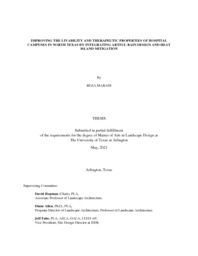
ATTENTION: The works hosted here are being migrated to a new repository that will consolidate resources, improve discoverability, and better show UTA's research impact on the global community. We will update authors as the migration progresses. Please see MavMatrix for more information.
Show simple item record
| dc.contributor.advisor | Hopman , David | |
| dc.contributor.advisor | | |
| dc.creator | Mabadi, Reza | |
| dc.date.accessioned | 2023-06-27T17:25:49Z | |
| dc.date.available | 2023-06-27T17:25:49Z | |
| dc.date.created | 2021-05 | |
| dc.date.issued | 2021-05-07 | |
| dc.date.submitted | May 2021 | |
| dc.identifier.uri | http://hdl.handle.net/10106/31322 | |
| dc.description.abstract | Despite these efforts and signs of progress, such design and planning efforts have failed to thoroughly integrate restorative design principles and sustainable strategies into the landscape architecture of healthcare facilities. The case studies presented in this research illustrate this phenomenon. Currently, sustainable approaches to evidence-based research on health and well-being necessitate a reexamination and reinvention of design methods and recommendations for hospital landscapes to improve their therapeutic properties. The main goal of this research is to investigate strategies to improve the livability and therapeutic values of the constructed landscape of Clements University Hospital through an evidence-based approach and to examine the generalizability of this method for other hospital campuses in North Texas. This study hypothesized that integrating sustainable strategies, such as heat island mitigation and artful rainwater design, as well as by improving views of hospital gardens by applying an evidence-based approach, can enhance the therapeutic properties and improve the livability of healthcare facilities.
This empirical research examined the constructed landscape of four hospitals within the same geographical and functional contexts. The researcher used the results and scientific evidence to establish a foundation for research-informed design recommendations. The researcher collected data via both primary and secondary sources. To analyze the data, this the researcher employed content analysis, preoccupancy evaluation via a survey, and spatial-comparative analysis. To collect and analyze the data, this research aimed to establish a set of baseline performance measures. These baseline measures helped to develop a set of design and planning recommendations for hospital sites and metrics to evaluate the final landscape design of hospitals in future studies.The results indicate that heat island mitigation strategies and artful rain design improve the livability of hospital campuses by disconnecting spatial continuity, increasing human comfort and safety, and planning for public gatherings and human activities. The results also suggest that improving garden views in a hospital encourages livability and increases the healing value of the site. Finally, the results reveal the extent to which improving landscape performance can increase the therapeutic value of the site. | |
| dc.format.mimetype | application/pdf | |
| dc.language.iso | en_US | |
| dc.subject | Therapeutic landscape | |
| dc.subject | Heat island effects | |
| dc.subject | Artful rain design | |
| dc.subject | Livability | |
| dc.subject | Dallas | |
| dc.title | IMPROVING THE LIVABILITY AND THERAPEUTIC PROPERTIES OF HOSPITAL CAMPUSES IN NORTH TEXAS BY INTEGRATING ARTFUL RAIN DESIGN AND HEAT ISLAND MITIGATION | |
| dc.title.alternative | Improving the livability and therapeutic properties of hospital campuses in North Texas by integrating
artful rain harvesting and heat island mitigation approaches. | |
| dc.type | Thesis | |
| dc.date.updated | 2023-06-27T17:25:49Z | |
| thesis.degree.department | Landscape Architecture | |
| thesis.degree.grantor | The University of Texas at Arlington | |
| thesis.degree.level | Masters | |
| thesis.degree.name | Master of Landscape Architecture | |
| dc.type.material | text | |
| dc.creator.orcid | 0000-0002-1718-979X | |
Files in this item
- Name:
- MABADI-THESIS-2021.pdf
- Size:
- 12.66Mb
- Format:
- PDF
This item appears in the following Collection(s)
Show simple item record


